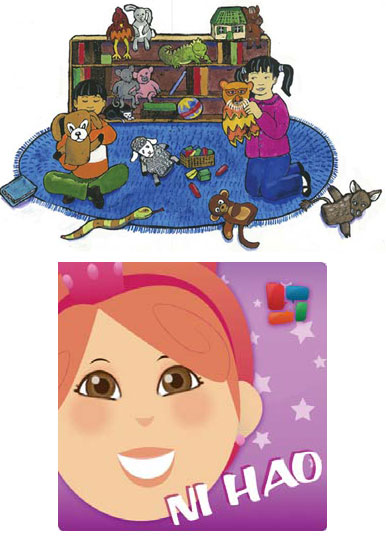Novel approaches to learning Chinese
Updated: 2012-12-14 08:44
By David Bartram (China Daily)
|
|||||||||
|
Top: Chinese and English Nursery Rhymes pairs rhymes in English and Chinese. Above: Princesses Learn Chinese is an app to teach children Chinese words. Provided to China Daily |
Parents, authors create new, interactive teaching methods
Parents looking to give their children a head start when it comes to learning Chinese today have access to an unprecedented range of resources, including books, apps and podcasts.
Franck Koestel began learning Chinese with his wife and two young children a year and a half ago. When he couldn't find a suitable app his children could use to help them learn, he went about building his own.
"Our 8-year-old daughter Elena loves princesses and she loves the iPad," Koestel says. "So since we loved languages and had some good Chinese friends and teachers, we said to ourselves, 'what about building an app to make it fun for Elena and other kids to start being exposed to Chinese'?"
The result was Princesses Learn Chinese, an interactive iPad and iPhone app designed to expose children to their first Chinese words.
"My wife and I designed the app. Over the Internet we found a group of committed professionals who love languages to help us make illustrations, voice-overs, music and to create the code for the app."
Princesses Learn Chinese takes a story-telling approach to language learning. Chinese words and expressions are introduced in the context of a story, and these words are reinforced through games and songs.
"Parents have told us that the app is great for introducing Mandarin," Koestel says. "Children like to play the little games and repeat the lyrics in the songs. We do not think that apps can replace what parents or teachers do. However, we believe that they can make Mandarin more accessible for children."
For the less tech-savvy, there is a growing market in books aimed specifically at young children who may be picking up their first words of Chinese.
Kieren Dutcher provides illustrations for Chinese and English Nursery Rhymes, a bilingual nursery book that pairs traditional rhymes in both English and Chinese.
"Nursery rhymes are a great way for children to learn any language," says Dutcher. "Rhyming and singing help with memory, making it fun and easy to remember the words, no matter what language you are learning.
"The illustrations help children visually to comprehend the text of a nursery rhyme or story. We've had some great reviews from parents. Many say their children love learning the melodies, and eventually the words."
Exposing children to spoken Chinese at a young age is key to the learning process. With this mind, Cao Aihua, born in China but now living and working in the Unites States, came up with a novel approach to teaching her US-born daughter Amy the language.
"When Amy was 5 in 2010, I decided to teach her Chinese in a systematic way because Chinese is one of the most spoken languages in the world," Cao says. "Since I planned to teach Amy Chinese, I thought it would be nicer to help more kids, teenagers and adults who are interested in learning Chinese."
Kids Chinese Podcast was born in 2010. Each lesson takes the form of Cao teaching Amy basic phrases, with Amy repeating back and interacting with her mother.
The format has proved a hit across the ages, with positive feedback coming from 4-year-olds who listen with their parents, to a 63-year-old who enjoys the simple, practical teaching methods.
"The podcast helps children learn Chinese while discussing the topics they are interested in. It is extremely helpful for language learning since listeners are in control of when and how they listen no matter where they are," Cao says.
For China Daily
(China Daily 12/14/2012 page11)

 Relief reaches isolated village
Relief reaches isolated village
 Rainfall poses new threats to quake-hit region
Rainfall poses new threats to quake-hit region
 Funerals begin for Boston bombing victims
Funerals begin for Boston bombing victims
 Quake takeaway from China's Air Force
Quake takeaway from China's Air Force
 Obama celebrates young inventors at science fair
Obama celebrates young inventors at science fair
 Earth Day marked around the world
Earth Day marked around the world
 Volunteer team helping students find sense of normalcy
Volunteer team helping students find sense of normalcy
 Ethnic groups quick to join rescue efforts
Ethnic groups quick to join rescue efforts
Most Viewed
Editor's Picks

|

|

|

|

|

|
Today's Top News
Chinese fleet drives out Japan's boats from Diaoyu
Health new priority for quake zone
Inspired by Guan, more Chinese pick up golf
Russia criticizes US reports on human rights
China, ROK criticize visits to shrine
Sino-US shared interests emphasized
China 'aims to share its dream with world'
Chinese president appoints 5 new ambassadors
US Weekly

|

|








